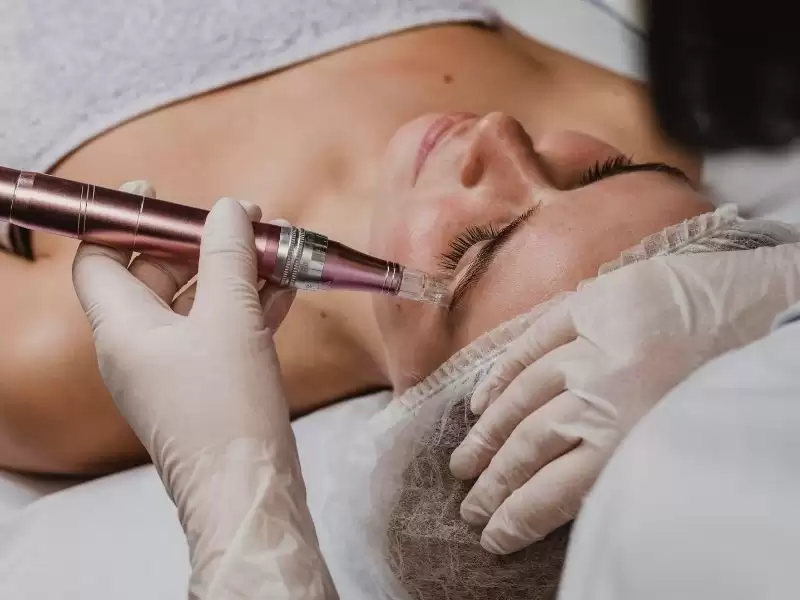All facial rejuvenation procedures aim to correct sagging caused by gravity and compensate for volume loss. However, they cannot provide a complete solution to the problem of aging skin. As we age, our skin becomes thinner, its quality deteriorates, and wrinkles and spots appear. To address these issues, peeling or skin renewal procedures are required.
Chemical peels performed with glycolic acid and diluted TCA, as well as laser applications, are carried out in the clinic without anesthesia. Deep chemical peels using TCA and phenol, along with dermabrasion, are performed in the operating room under general anesthesia or sedation.
What Should and Shouldn’t Be Done Before the Procedure?
As with all surgical procedures, skin repair treatments require discontinuing aspirin and smoking three weeks before the procedure. During the last week, medications or substances that may thin the blood should be avoided. Facial peelings, particularly in patients who have used Roccutane for acne treatment, should not be performed for one year.
When applied after applying cream to the skin, chemical peels and laser procedures using mild acids are performed. Chemical peels and dermabrasion procedures that use stronger acids require general anesthesia or deep sedation and are carried out under surgical conditions.

What Happens After Chemical Peeling?
After mild acid peels and laser treatments, patients can return home immediately. Some redness and crusting may occur in certain areas. Most patients can return to work after just one day. Following deep peels and dermabrasion, a crust forms and typically falls off within 7–10 days. When the crusts shed, a renewed pink skin surface appears. Therefore, patients can usually return to work after about 10 days. Skin should be protected from sunlight for at least six months after the procedure. For this reason, superficial skin renewal is most often performed during the winter months.
If the peel is done too deeply, healing problems and scarring may occur. Such complications are more likely after dermabrasion. Deep dermabrasion may heal with permanent scars. After laser treatment, pigment loss and irreversible fading may occur, while chemical peeling may sometimes result in darkening of the skin. If patients do not protect their skin adequately from the sun after peeling, spots and discoloration may develop.
What Is Chemical Peeling?
Chemical peeling refers to the process of exfoliating the skin using various chemical substances. Depending on the depth of the procedure, chemical exfoliations are categorized as superficial, medium, or deep peels. The most commonly used superficial chemical peels are alpha hydroxy acids (AHAs), among which glycolic acid and lactic acid are frequently preferred. In addition, salicylic acid is especially favored for acne treatment. For deeper peels, agents such as trichloroacetic acid (TCA) are used. The skin can be peeled at different depths depending on the specific problem being treated. The number of sessions varies between 5 and 15, depending on the severity of the issue. This treatment can reduce acne, wrinkles, spots, scars, and stretch marks.
Irritant contact dermatitis may occur during chemical peeling, but this is quite rare. Therefore, patients should have a detailed medical history, and their skin should be carefully examined before the procedure. It is preferably performed during the winter season. Even on healthy skin, applying several sessions of chemical peeling every winter can result in a brighter and more radiant complexion.
Biopsies have shown that the use of chemical peels helps mature collagen tissue, thereby reducing the formation of superficial wrinkles. For superficial peels, sessions are performed once a week, while for deep peels, sessions are scheduled every 15 days to one month. This procedure removes the upper layer of the epidermis, which has lost its vitality and brightness, revealing new, fresh skin beneath. At the same time, it stimulates cell regeneration and collagen production in the deeper layers of the skin, accelerating rejuvenation. Medical and cosmetic products prescribed and applied by a doctor before and after the procedure enhance the effectiveness of chemical peels.
In Which Areas Can Chemical Peeling Be Applied?
Although this procedure is mainly applied to the face, it can also be applied to the neck and hands. From this aspect, it is a very effective and practical procedure. The rough, colored upper layer of the skin is cleaned, and a more moist, smooth, healthy, light-reflecting skin is obtained, eliminating spots, various blemishes, and wrinkles.
Superficial peeling is the best removal of the stratum corneum, which corrects the structure of the skin and stimulates the formation of a thick surface layer of the skin. For surface peeling, 10–25% trichloroacetic acid (TCA), Jessner’s solution, alpha hydroxy acid (AHA), salicylic acid, and tretinoin solution can be used. It is an effective method to correct pigmentation changes, correct lighter and moderate wrinkles, cause destruction of the papillary and upper reticular dermis, and treat actinic keratosis to correct the effects of photoaging.
Click here for information about Skin Rejuvenation.






